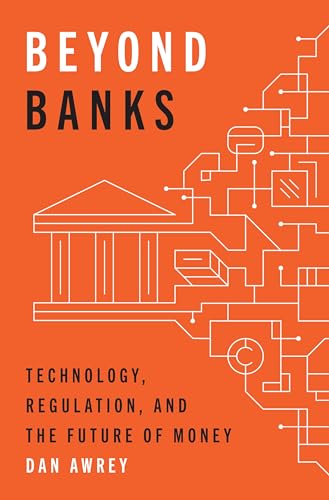Beyond Banks: Technology, Regulation, and the Future of Money
In an age where technology is constantly reshaping our financial landscape, “Beyond Banks” by Dan Awrey offers critical insights into the evolving relationship between technology, regulation, and the future of money. This transformative book discusses the impact of fintech innovations on traditional banking structures and the need for regulators to adapt to this fast-paced environment. Awrey’s expertise helps illuminate the pathways that connect modern technology and regulatory frameworks, making it an essential read for policymakers, bankers, and finance enthusiasts alike. Discover how our notion of banking could change forever and why anticipating the future is crucial.
Bank Regulation, Risk Management, and Compliance (Practical Finance and Banking Guides)
Alexander Dill’s “Bank Regulation, Risk Management, and Compliance” is a vital resource that delves into the intricacies of banking compliance amid an ever-evolving regulatory landscape. This book is tailored for professionals who seek to understand the practical aspects of risk management, focusing on compliance practices that ensure financial institutions navigate through regulatory challenges successfully. Dill’s work equips readers with tools and knowledge fundamental to sustaining corporate governance, making this a must-read for industry practitioners and students.
Financial Regulation: Law and Policy (University Casebook Series)
“Financial Regulation: Law and Policy” by Michael Barr, Howell Jackson, and Margaret Tahyar serves as an authoritative guide to the complex world of financial regulation in the U.S. With its comprehensive overview of major regulatory laws and policies, this casebook is indispensable for students and practitioners interested in understanding how law shapes financial markets. The authors illuminate the significant challenges facing regulators, particularly in light of globalization and technological disruption. Their blend of theory and practical case studies makes this a crucial reading for those looking to navigate this dynamic field.
Regulation of Lawyers: Problems of Law and Ethics
In his work “Regulation of Lawyers“, Stephen Gillers tackles the pressing issues surrounding legal practice and ethical compliance. This book is not only a textbook for law students but also a requisite guide for practitioners who wish to stay informed about ethical dilemmas they may encounter. With engaging narratives and real-world implications, Gillers challenges readers to contemplate the complexities of law and ethics, making it essential for aspiring and current legal professionals.
EU Banking Law and Regulation
Gianni Lo Schiavo’s “EU Banking Law and Regulation” navigates the maze of European banking regulations, offering insights into the policies that govern the continental financial landscape. This book is essential for understanding how EU laws shape banking operations and affect compliance strategies across member states. Lo Schiavo elucidates the complexities of EU directives and their implementation, providing readers with a solid grounding in how European regulations impact global banking practices. This is an indispensable continuation for those engaging with banking law.
Principles of Banking Regulation
Principles of Banking Regulation by Kern Alexander offers a foundational overview that is crucial for understanding how banking systems operate within the regulatory framework. This book is a synthesis of various banking principles and focuses on the rationale behind banking regulations aimed at ensuring the stability of financial systems. Alexander provides a balanced perspective, outlining the ethical considerations that bind financial institutions while emphasizing the practicalities of banking operations. It’s a must-read for those in finance who need to grasp the principles that guide regulatory practices.
Banking Law and Regulation
“Banking Law and Regulation” by Iris H-Y Chiu and Joanna Wilson offers a contemporary perspective on banking law’s complexities. The authors explore both core concepts and the dynamic regulatory landscape affecting banks worldwide. This book shines a light on recent developments and pragmatic approaches to compliance, presenting case studies that offer practical insight into real-world challenges faced by banking institutions. A vital read, this work equips legal practitioners with the understanding necessary to navigate the ever-evolving framework of banking regulation.
Principles of Financial Regulation
“Principles of Financial Regulation” compiles wisdom from several prominent authors including John Armour and Dan Awrey, offering a comprehensive look at the philosophy behind financial regulation. This book articulates the concepts of regulation through detailed analyses of legal principles, aiming to educate readers on the importance of sound regulatory practices in fostering a stable economic environment. Perfect for legal scholars and regulatory professionals alike, it encourages critical thinking around the frameworks that support financial markets.
Banking Regulation in the United States 3rd Edition
Carl Felsenfeld and David Glass present a thorough exploration of the laws governing banking practices in their book, “Banking Regulation in the United States“. This updated edition discusses current regulations and addresses the ongoing changes in a post-financial crisis landscape. Their clear analyses and insights into the regulatory mechanisms provide readers an indispensable resource on U.S. banking law, making this a must-have for both practitioners and students looking to understand the regulatory environment.
Foundations of Banking Risk: An Overview of Banking, Banking Risks, and Risk-Based Banking Regulation
The “Foundations of Banking Risk” by the Global Association of Risk Professionals (GARP) provides an essential overview of bank risk management. This book dives deep into the intricacies of banking risks and the regulatory measures in place to mitigate them, offering readers a comprehensive understanding of risk-based banking regulation. With its straightforward explanations and well-structured content, it becomes essential for professionals wishing to refine their risk management approaches. This resource is a practical guide that encompasses theory along with the application.














































